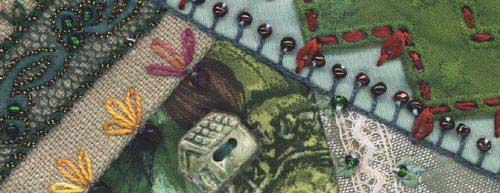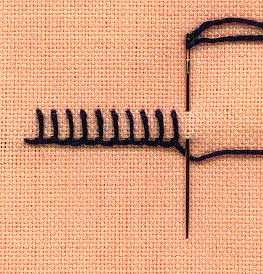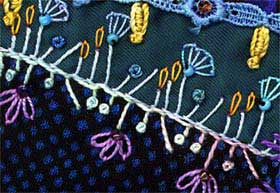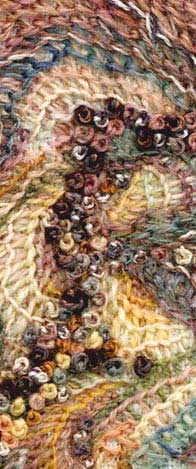Buttonhole Stitch


Buttonhole stitch is also known as blanket stitch because it was often used as an edging on blankets.
This stitch is worked from left to right over two imaginary lines. Bring the thread out on the lower line, insert the needle in position in the upper line making a straight downward motion and then loop the thread under the needle point. Pull the needle through the fabric to form a loop and repeat this process along the line.
By altering the lengths of the upright stitches buttonhole can be both decorative and practical. Basic buttonhole stitch is the foundation for a family of stitches.
 The upright lengths can also be varied to form pyramid shapes. Rows of the stitch can be built up to create patterns or it can be worked back to back as in the illustration below. It is an ideal stitch to use as a seam embellishment in crazy quilting as the spines can be further decorated with detached chain, french knots, colonial stitch or beads.
The upright lengths can also be varied to form pyramid shapes. Rows of the stitch can be built up to create patterns or it can be worked back to back as in the illustration below. It is an ideal stitch to use as a seam embellishment in crazy quilting as the spines can be further decorated with detached chain, french knots, colonial stitch or beads.
Buttonhole can also be worked in freeform manner with rows stacked to create texture as in the illustration to the right. The illustration is worked in a fine woollen yarn which was hand dyed.

It is also useful to use buttonhole stitch or arrangements of buttonhole to couch textured threads.
In another variation the row of loops at the base of the stitch can be whipped or threaded with a contrasting colour.
There are many other stitches that are classified in this group. The stitches that I have listed here in the Buttonhole family are:
- Barb stitch
- Berwick stitch
- Bonnet stitch
- Buttonhole Bar
- Buttonhole wheel
- Closed Buttonhole stitch
- Closed Feather stitch
- Crossed Buttonhole stitch
- Detached buttonhole stitch
- Feather stitch
- Rosette of thorns
- Up and Down Buttonhole
- Up and Down buttonhole feathered
